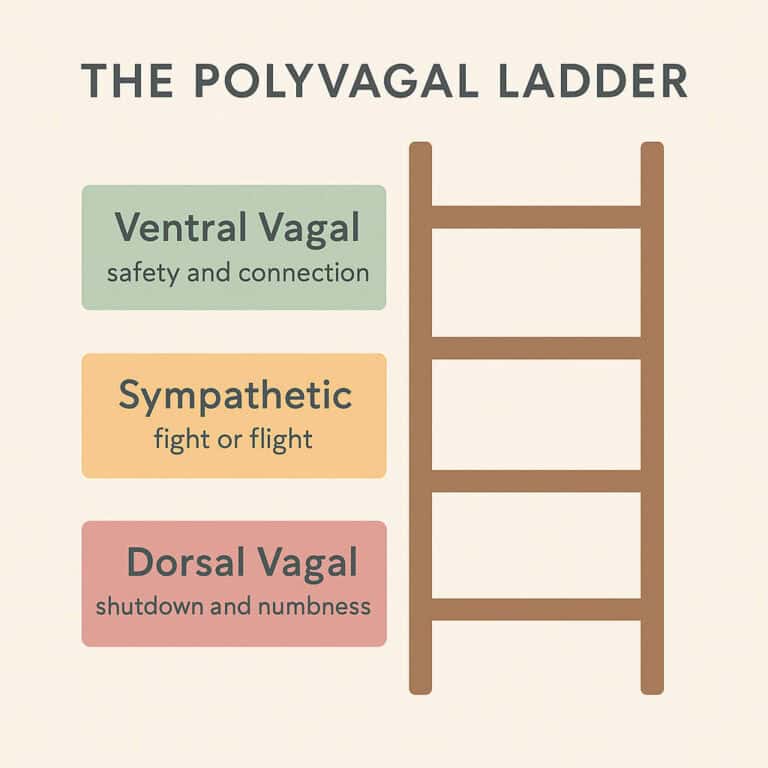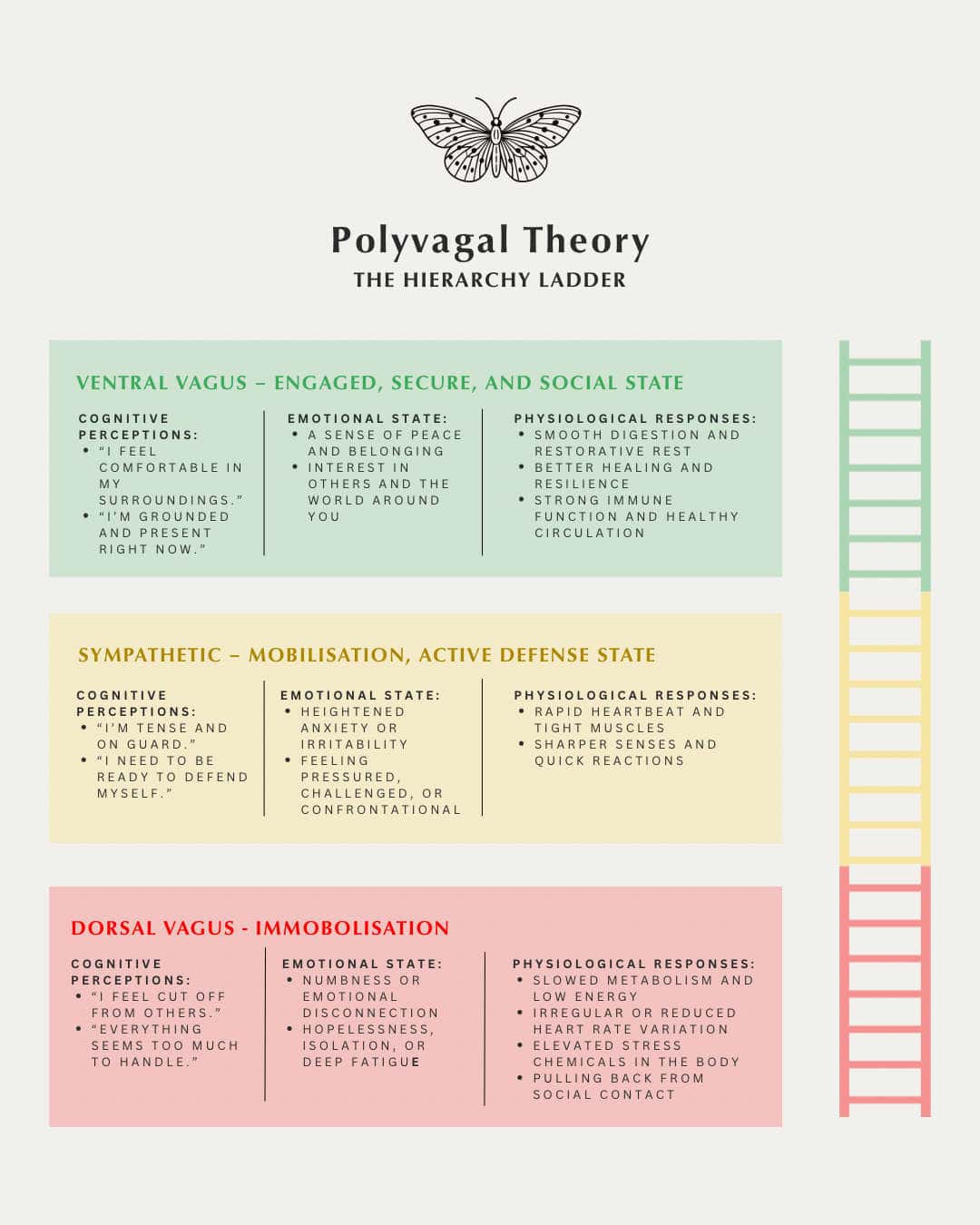The Polyvagal Ladder
Finding Your Way Back To Safety
If you are exploring nervous system regulation, the polyvagal ladder gives you a simple way to understand why your body sometimes feels open and connected, then at other times anxious, flat, or far away.
It is not about forcing yourself to be calm, it is about noticing where you are on the ladder and learning gentle ways to move toward safety again. That is the work we do together here.
Your nervous system is like a quiet guardian, always listening, always asking, am I safe. It moves you through life like steps on a ladder. Some days you feel clear and steady at the top. Other days you sense pressure building and you brace in the middle.
Sometimes you drop to the bottom and everything slows. None of this means you are broken. This is your body keeping you alive in the best way it knows how. When we understand the pattern, we can find our way home more easily.

What Is The Polyvagal Ladder
Polyvagal theory, developed by Dr Stephen Porges, describes three core autonomic states that your body cycles through. Think of them as rungs on a ladder. The top rung is ventral vagal, the place of safety and connection. The middle rung is sympathetic, the place of mobilisation for fight or flight. The bottom rung is dorsal vagal, the place of shutdown and numbness when things feel too much. We all move between them. The aim is not to live only at the top, the aim is to recognise the rungs and regain flexibility, so your system can respond and return.
The Three Rungs Of The Polyvagal Ladder
Ventral vagal, safety and connection, top rung
This is the sweet spot where your body feels grounded and available for life. Breathing is easy, thoughts are clearer, and it is simpler to be with other people. You can make eye contact, listen, laugh, learn, and recover. Healing settles in more deeply here because your system feels safe enough to rest and repair.
Sympathetic, fight or flight, middle rung
When there is a perceived threat, your body mobilises. Heart rate increases, muscles prepare for action, focus narrows. You might feel alert, restless, irritable, or driven. This is useful when you truly need to respond, although if it lingers it becomes exhausting and can leave you feeling wired and disconnected from yourself and from others.
Dorsal vagal, shutdown and numbness, bottom rung
If the system decides there is no way to escape or solve the problem, it moves into conservation. Energy drops. You may feel heavy, spaced out, or detached, as though you are watching life from somewhere else. This is protection, not failure. Staying here for too long can feel hopeless, and that is why gentle steps back toward connection matter.

Why This Ladder Matters For Healing
Safety is the foundation for change. When the body does not feel safe, it is harder to process memories, learn new behaviours, or connect with the people who could help. The polyvagal ladder gives you a map. Instead of wondering what is wrong with me, you can ask, where am I right now, and what would help me climb one rung.
Common signs you can observe
• Top rung, ventral, you feel present, curious, engaged, and able to rest
• Middle rung, sympathetic, you feel tense, fast, urgent, or easily startled
• Bottom rung, dorsal, you feel slow, flat, foggy, withdrawn, or alone
None of these states are bad. They are intelligent adaptations. To achieve vagus nerve healing, you need to learn to notice them sooner, to meet them with kindness, and to offer your body experiences that signal safety.
How To Notice Your State In Real Time
Self awareness grows through small, repeatable check ins. Try this a few times a day, even when you feel fine. Ask, where am I on the polyvagal ladder. Look for three simple markers, breath, body, and connection. Is your breath long or tight. Is your body soft or braced. Do you feel open to others or more defended. Your answers do not need to be perfect. You are building a relationship with your nervous system, and relationships deepen with practice.
Gentle Ways To Climb One Rung
You do not need to leap from bottom to top. Small steps matter. Choose what feels doable today, not what looks impressive. If you are in the middle rung, short bursts of movement can help discharge energy, then follow with something slow. If you are on the bottom rung, think simple and sensory, warmth, weight, rhythm, and a trusted voice.
Simple practices to try
Breath and body
- Lengthen your exhale
- Hum softly, sway, or rock
- Add warmth with a blanket
- Place a hand over your chest or belly
- Let your jaw soften
Connection and environment,
- Look at faces you trust
- Call someone who is calm
- Listen to a familiar piece of music
- Step outside for daylight
- Orient to the room by naming three things you can see and three things you can hear
Perhaps one of these will work on a Tuesday and not on a Friday. That is normal. Your body is giving you feedback in real time. Follow what softens you rather than what you think should work.

Wholeness Means Welcoming All Parts Of You
The aim is not to banish sympathetic energy or dorsal retreat. Both exist for a reason. Many of us learned to survive by moving quickly or by disappearing. Those strategies deserve respect. Over time, we invite them to relax, not by force, but by consistently offering safety. I have seen people shift after years of feeling stuck. Not with a grand breakthrough, but with a series of small, kind choices that their body starts to trust.
The Climb Back Up, What It Feels Like
Often there is a moment, quiet and unremarkable, where you notice a longer breath, or a little spark of interest, or the urge to reach out. These are signs of upward movement on the polyvagal ladder. You might not feel amazing, you might just feel a touch more you. That counts. From there you can do the next small thing, drink water, step into fresh air, send a message to a friend, watch something that makes you smile, prepare something nourishing. The nervous system learns by experience, so give it good ones, repeatedly.
Working With Me
In sessions, we use the polyvagal ladder as a shared language. Together we map your patterns, the signals your body gives before you slide, the supports that help you rise, and the environments that make it easier to stay steady. I will guide you through practices you can use between sessions, so your progress does not depend on a single hour each week. It is a gentle approach, and it respects your pace.
Frequently Asked Questions
Not exactly. Mindfulness is a wider skill of paying attention with curiosity. The polyvagal ladder explains why your state changes, and what kinds of inputs help you shift. They work beautifully together.
It varies. Some shifts happen within minutes. Longer patterns may take weeks or months to soften. Think consistency over intensity. Your system changes with repetition and safety.
Start with external cues. Warmth, weight, gentle rocking, and orienting to the room can help you sense more. We can build interoception step by step, there is no rush.
Yes, and support helps. Many people find that learning the map with a guide makes it easier to notice early signs and choose the right practice for the moment.
No. Mobilisation is useful when you need to act. Brief dorsal pauses can appear in everyday life. We pay attention when a state becomes sticky, frequent, or distressing.
In Short
The polyvagal ladder is a compassionate map of your inner world. It shows where safety lives in your system, and how to move toward it. You do not have to jump rungs. A slower breath, a warm mug in your hands, a friendly face, a walk outside, these are steps towards vagus nerve healing.
Over time, you build flexibility, and with flexibility comes trust, connection, and the sense that your body can bring you home again.
If this speaks to you and you would like guidance with nervous system regulation, you are welcome to reach out. We can explore where you are on the ladder today, and begin the gentle climb, one rung at a time.
